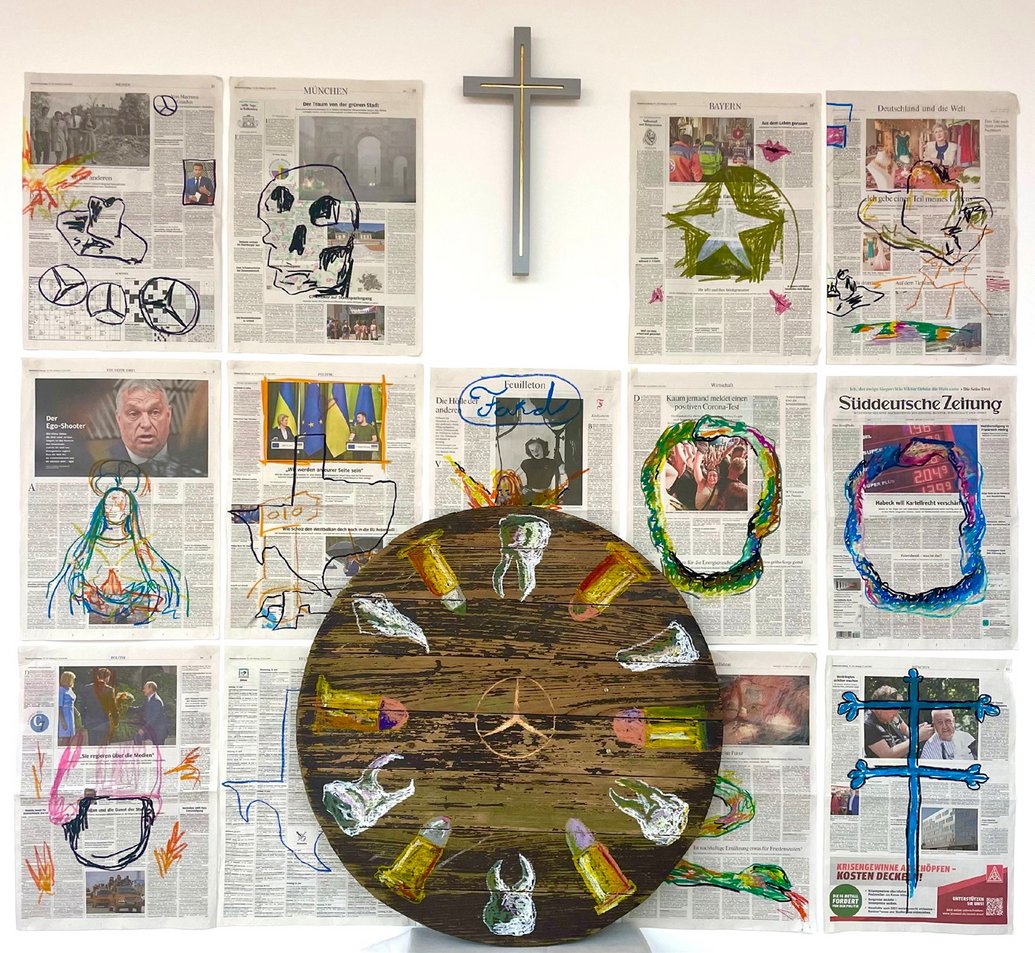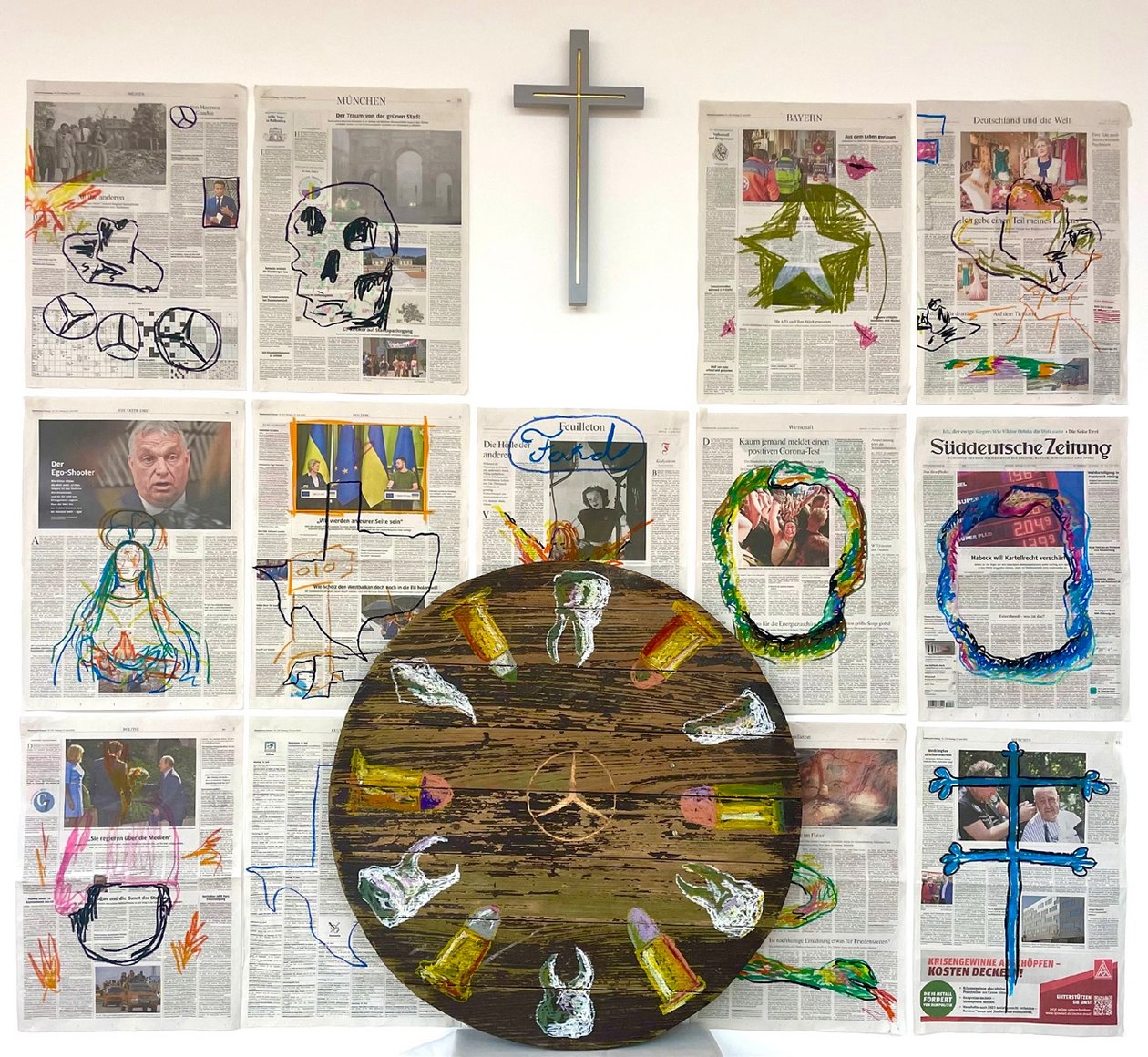Mercedes in War and Peace
Info:
History, war and art exert a great influence on the fate of people. Finley Jacobsen is sure of that. He therefore devotes himself to remembering and forgetting. His work „Mercedes in War and Peace“ serves as an example. Finley Jacobsen says that every remembrance is accompanied by a distortion of the truth, whether intended or not. Similar to the retelling of stories. That‘s why he tries to get to the root with his art. He implicitly raises the question that everyone can ask: How would history have to be told from as truthful an observation as possible? For his artwork, Finley stages a found object from the vicinity of his German workplace: a discarded wooden well cover. It was a chance find: visibly robbed of its function, lying around carelessly, abandoned to successive rotting. Like sometimes aspects of our history. This wooden disc becomes the center of his altarpiece. Finley carves a Mercedes star into the well cover. He frames it with painted teeth and cartridges. They symbolize human sacrifice and gun violence. Painted pages of a German daily newspaper form the altar panels, which open upward to a cross. Simplistic symbolic drawings adorn the current news stories, which include the forward push of the autocracy, the state of our nature, the pandemic, the economic crisis, the war in Ukraine, worldwide protests, but also people in difficult situations. Finley deliberately paints over the information communicated as truthfully as possible through good journalism in a childish crude manner:
- Cowboy symbols representing the conquest of the land, but also the start of agriculture and industrialization,
- a skull as a memento mori,
- a green shield with a white star, military icon in the U.S., found mainly on airplanes and on the Willys jeep, and still used today,
- the Virgin Mary as a symbol of purity,
- the map outline of Texas, close ally of Bavaria in the U.S.A.,
- Ford and a fireball: Ford, like BMW among others, was also a producer for the 2nd World War,
- two self-eating snakes, symbol of successive self-destruction,
- a German helmet, pink-colored: The symbol of destruction in World War II thus draws attention to the soft side of the people who, as soldiers, endure the brutality of war,
- a snake with a hissing tongue crawling out from behind the center of the altar: a reminder that evil lurks everywhere,
- the patriarchal cross, on the one hand a religious symbol inviting to prayer, on the other hand misused until today as a justification for acts of war.
With his altarpiece, the artist and political scientist from L.A. shows how history is documented and guilt assigned. The „producers“ of National Socialist ideology were tried and convicted at Nuremberg; producers of war equipment who kept forced laborers and profited from the Nazi regime got off relatively scot-free. These are often companies that are still very successful today. Finley calls for us to be aware of such contexts of collaboration and their effects, and for those affected to be open about them.

Über den Künstler

Finley Jacobsen
21 Jahre
Der Künstler über Demokratie und Frieden
Mein Name ist Finley Jacobsen, ich bin 22 und komme aus Los Angeles, Kalifornien. Ich studiere an der Wesleyan University, Connecticut, im Hauptfach Government und Studio Art. Seit meiner Jugend bin ich von Kunst und Geschichte fasziniert. Mit ca. 6 Jahren haben mich Krieg und Wahrheit zutiefst beeindruckt. Mein Interesse äußerte sich v.a. dadurch, dass ich dazu viel zeichnete und Filme über den Krieg sehen wollte. Mit den Jahren begann ich zu verstehen, dass die Dinge, die wir als historische Wahrheiten, festgefahrene politische Doktrinen oder sogar Rechtfertigungen für Kämpfe akzeptieren, oft nicht so sind, wie sie erscheinen. Sie sind tatsächlich ständig im Wandel. In meiner Kunst geht es um den Tod, das Sterben, die Geschichte und die amerikanischen Träume. Alles Konzepte, die immer im Fluss sind. Ich versuche, die surrealistische Natur der heutigen Existenz darzustellen und gleichzeitig die Bedeutung der Vergangenheit zu untersuchen. Ich versuche, alltägliche Systeme und Wahrheiten, an die wir uns so sehr gewöhnt haben, in Frage zu stellen, wie z. B. wirtschaftliche Strukturen, Technologien, Regierungssysteme, Krieg und Führung, um ein tieferes Verständnis dieser quasi abstrakten Ideen zu erreichen. Dafür nutze ich lockere Zeichnungen mit Pastellkreiden, kombiniere sie mit Ölfarben, Ölstiften und Schnitzereien auf Holz. Meine Absicht ist, den wahrhaft verwirrenden, zerstörerischen Charakter von Krieg und Politik ebenso hervorzuheben, wie deren Einfallsreichtum.








